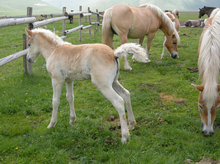Now that winter is well on its way, many horse owners are beginning to think about their pastures and ways to improve the amount of forage available for their horses.

Better pasture - Better horse health
Productive, well-managed pastures can provide most of the feed requirements of horses for the least cost.
According to Penn State Extension Services, high-quality, properly fenced pastures are one of the best and least expensive sources of summer feed for a horse. A well-kept pasture also is the most natural and healthy environment for exercise and rest.
Productive, well-managed pastures can provide most of the feed requirements of horses for the least cost. Good pasture alone is sufficient to meet all of the nutritional requirements for many classes of horses. At the same time, poorly managed pastures supply little or no feed and frequently are the source of internal parasites.
If pasture is a feed source, horses with a mature weight of 1,000 to 1,200 pounds generally need the following amount of pasture: mare and foal, 1.75 to 2 acres; yearlings,1.5 to 2 acres; and weanlings, 0.5 to 1 acre.
When acreage is very limited (less than an acre per horse), exercise may be the main pasture use. In that case, pasture will supply only a minimal amount of feed. Establishing a rotational grazing system is the best way to maximize forage production and consumption on limited pasture acreage. A group of compatible horses can graze a paddock (area of divided pasture) for approximately 3 to 6 days, then be moved (rotated) to a fresh paddock.
Limed and fertilized Kentucky bluegrass should be the main grass in this system, because it withstands close and continuous grazing better than most other grasses. When well established and properly fertilized, it produces a reasonably dense and attractive sod.
Horse pasture improvement
If you already have good stands of desirable grass and legume species, you can maintain a satisfactory horse pasture with proper soil fertility and management practices. Most permanent bluegrass pastures produce less than 2,000 pounds of dry matter per acre per year, which is far below their potential. Yields on many pastures can be doubled simply by applying lime and fertilizer.
Liming and topdressing Kentucky bluegrass pastures with phosphate, potash, and nitrogen costs much less and is less work than completely renovating the pasture. It may even be possible to have lime and fertilizer custom-applied for a relatively low cost.
A soil test will determine pH (acidity), nutrient levels, and requirements. Soil testing kits and information on how to take samples are available through most county extension offices.
The response often is slow when lime and fertilizer are applied on the surface of established pastures. Depending on the lime needs and species present in the pasture, it may take one to three years for the sod to become thick and productive again.
Pasture renovation
If you do not have a good stand of desirable species, you may want to renovate the pasture by destroying the existing plants and introducing productive mixtures. This process usually results in the highest yield increase per acre, but will be relatively expensive to complete.
The following steps are recommended for pasture renovation:
- Soil test to determine exactly how much lime and fertilizer are needed.
- Apply required lime several months before seeding. Disk or plow to mix lime evenly with the soil. If large amounts of fertilizer are to be applied, it should be disked into the soil prior to planting.
- Small amounts of fertilizer can be applied through the seeder at planting.
- Select a seed mixture that complements the pasture drainage characteristics. Destroy or suppress old pasture by plowing or using herbicides.
- Use the appropriate method of seeding, based on extent of tillage. Protect the seeded area until new plants are well established.
When recommended mixtures are seeded without a companion crop and weeds are controlled, new seedings can become established in a single year. While generally considered less palatable than bluegrass, tall fescue produces one of the toughest sods of any adapted grass.
It may be used in heavy traffic areas, along fences, and around gates and water troughs. Older stands of fescue often are infested with an endophyte, a fungus within the plant. In mares, toxins associated with this fungus can lower reproductive rates and cause abortion, agalactia (lack of milk), and prolonged gestation.
Use endophyte-free tall fescue seed to establish new fescue stands for horses. Brood mares should be removed from pastures containing endophyte infested tall fescue at least 90 days prior to foaling.
Read more about Fescue Toxicity in Mares
